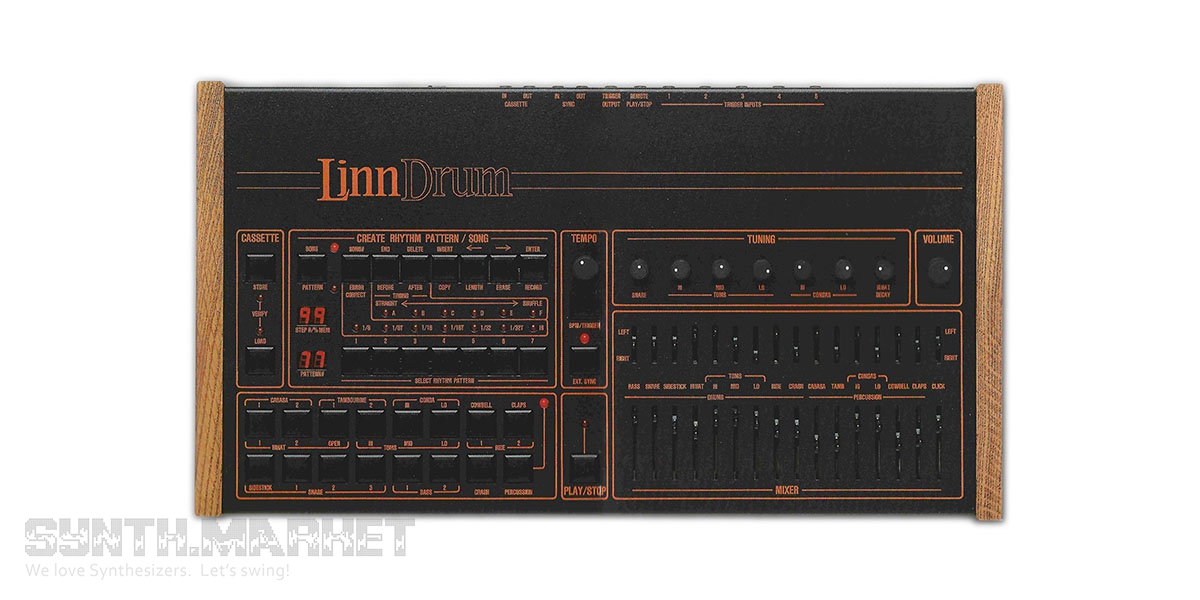 When Roger Linn was working on his LinnDrum (LM-2) he had intriguing ideas of “real drums” introduction. To implement his wish he invited session drummer Art Wood with whom he recorded a lot of samples. Its release in 1982 (as well as the release of LM-1) marked the device to be one of the first drum machines featuring samples of real acoustic drums in electronic format. The “big box” offers the library of 15 drum types: bass, snare, clap, rimshot, hi-hat, crash, ride, tom, kabasa, tambourine, conga, cowbell. The instrument strikes both with its quality and the number of sounds. Each drum type has its own input so it can be processed individually, its own pan and volume faders. “Tuning” section can change the pitch of certain drums: snare, tom, conga and hi-hat decay. The retro drum machine has 56 user presets with real time recording possibility or saving in a step mode. Moreover to make the operation easier there are quantization and swing settings.
When Roger Linn was working on his LinnDrum (LM-2) he had intriguing ideas of “real drums” introduction. To implement his wish he invited session drummer Art Wood with whom he recorded a lot of samples. Its release in 1982 (as well as the release of LM-1) marked the device to be one of the first drum machines featuring samples of real acoustic drums in electronic format. The “big box” offers the library of 15 drum types: bass, snare, clap, rimshot, hi-hat, crash, ride, tom, kabasa, tambourine, conga, cowbell. The instrument strikes both with its quality and the number of sounds. Each drum type has its own input so it can be processed individually, its own pan and volume faders. “Tuning” section can change the pitch of certain drums: snare, tom, conga and hi-hat decay. The retro drum machine has 56 user presets with real time recording possibility or saving in a step mode. Moreover to make the operation easier there are quantization and swing settings.
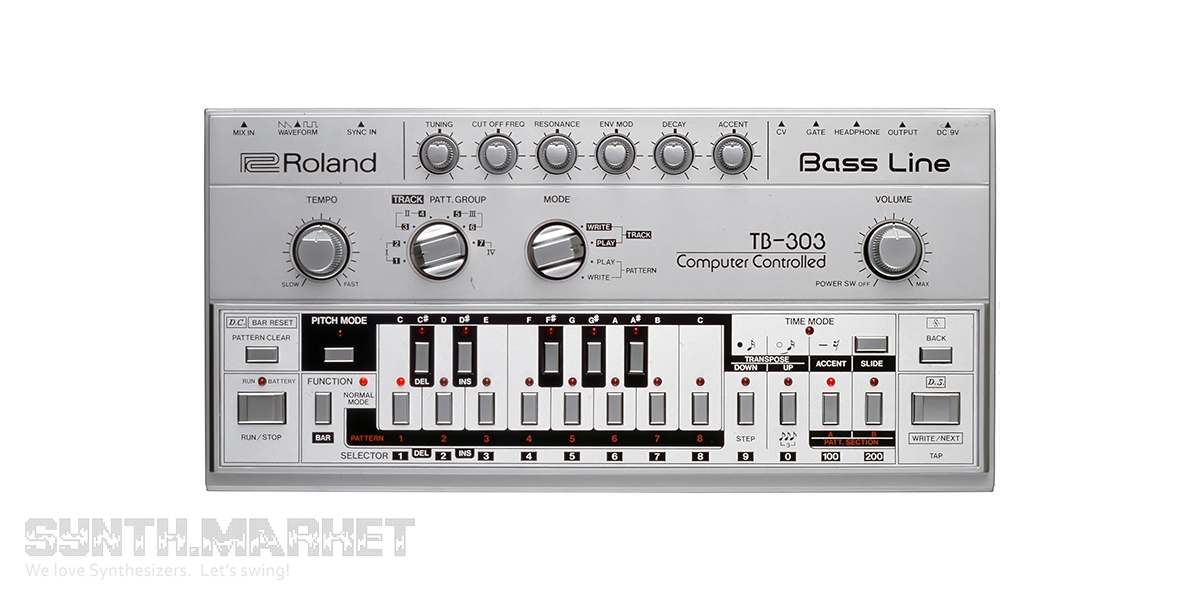 Roland TB-303 was launched the same year LM-2 was and appeared to be acid house classics, anyway it was capable not only of proper acid sequencies but of decent drums as well. This quite an unusual approach may seem a bit weird but that’s exactly why it can be considered a truly versatile beast. Having just one VCO with 2 waveforms (sawtooth and square) it enables unlimited options for aggressive kick or percussion creation. VCF with adjustable cutoff and resonance also contributes to synthesis. For example if you need bass drum or bubble percussion the sawtooth wave will do great, if you need claves the square waveform is there for you. TB-303 was intended to be the synth you can use with no necessity of having a bass guitar player. While some rejected TB-303 others put it on the list as a must have. Today it beautifies the collections of many many electronic musicians.
Roland TB-303 was launched the same year LM-2 was and appeared to be acid house classics, anyway it was capable not only of proper acid sequencies but of decent drums as well. This quite an unusual approach may seem a bit weird but that’s exactly why it can be considered a truly versatile beast. Having just one VCO with 2 waveforms (sawtooth and square) it enables unlimited options for aggressive kick or percussion creation. VCF with adjustable cutoff and resonance also contributes to synthesis. For example if you need bass drum or bubble percussion the sawtooth wave will do great, if you need claves the square waveform is there for you. TB-303 was intended to be the synth you can use with no necessity of having a bass guitar player. While some rejected TB-303 others put it on the list as a must have. Today it beautifies the collections of many many electronic musicians.
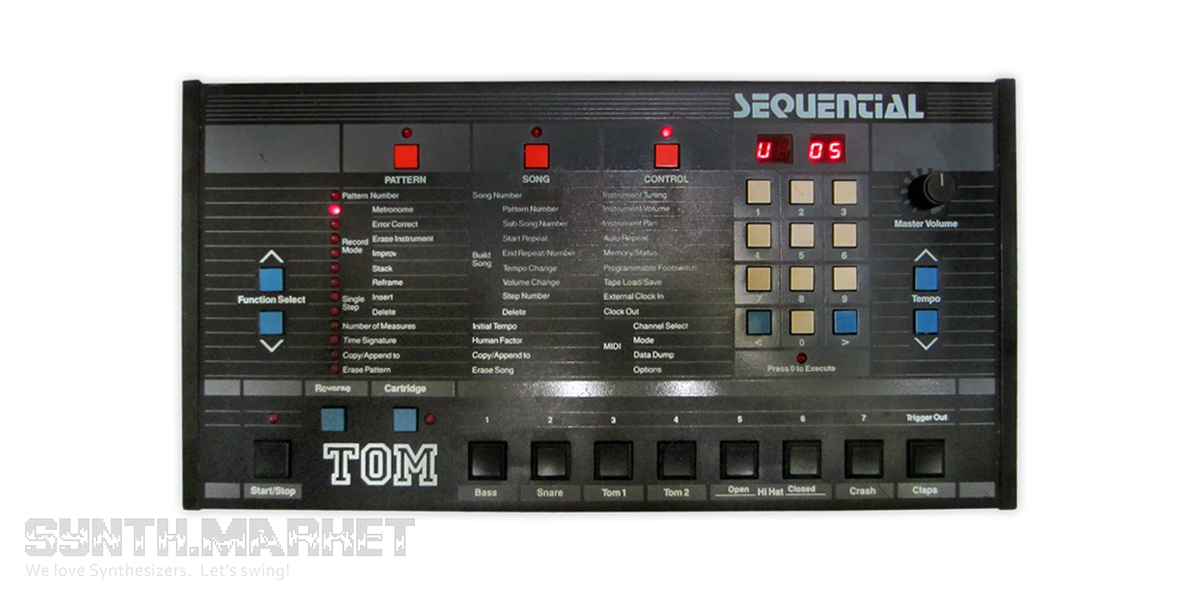 Our next vintage drum point is famous for its minimalist interface, friendly programming and digital samples of high quality. It was presented by Sequential Circuits in 1985 and is called TOM. First touch might bring some prejudice but it will go in five minutes after you get acquainted. The instrument possesses a standard set of 8 drum sounds but each sample can compete with any of those from other leading products. Plus all the samples can be altered thanks to pitch control. You can also use layer function the drum machine offers. To make kick more expressive you can increase “click” intensity, to add some sonic space you might as well combine snare with tom or create some “arrhythmia”. Even more – almost each sample can be reversed. The sequencer includes 99 patterns which can be connected directly to the music tracks. To find an alternative to such a machine (among retro ones) with such specifications you’ll spend half of a lifetime. Considering all abovementioned we can claim that SCI TOM is a greatest drum machine of its time and today it’s probably as much significant as it used to be.
Our next vintage drum point is famous for its minimalist interface, friendly programming and digital samples of high quality. It was presented by Sequential Circuits in 1985 and is called TOM. First touch might bring some prejudice but it will go in five minutes after you get acquainted. The instrument possesses a standard set of 8 drum sounds but each sample can compete with any of those from other leading products. Plus all the samples can be altered thanks to pitch control. You can also use layer function the drum machine offers. To make kick more expressive you can increase “click” intensity, to add some sonic space you might as well combine snare with tom or create some “arrhythmia”. Even more – almost each sample can be reversed. The sequencer includes 99 patterns which can be connected directly to the music tracks. To find an alternative to such a machine (among retro ones) with such specifications you’ll spend half of a lifetime. Considering all abovementioned we can claim that SCI TOM is a greatest drum machine of its time and today it’s probably as much significant as it used to be.
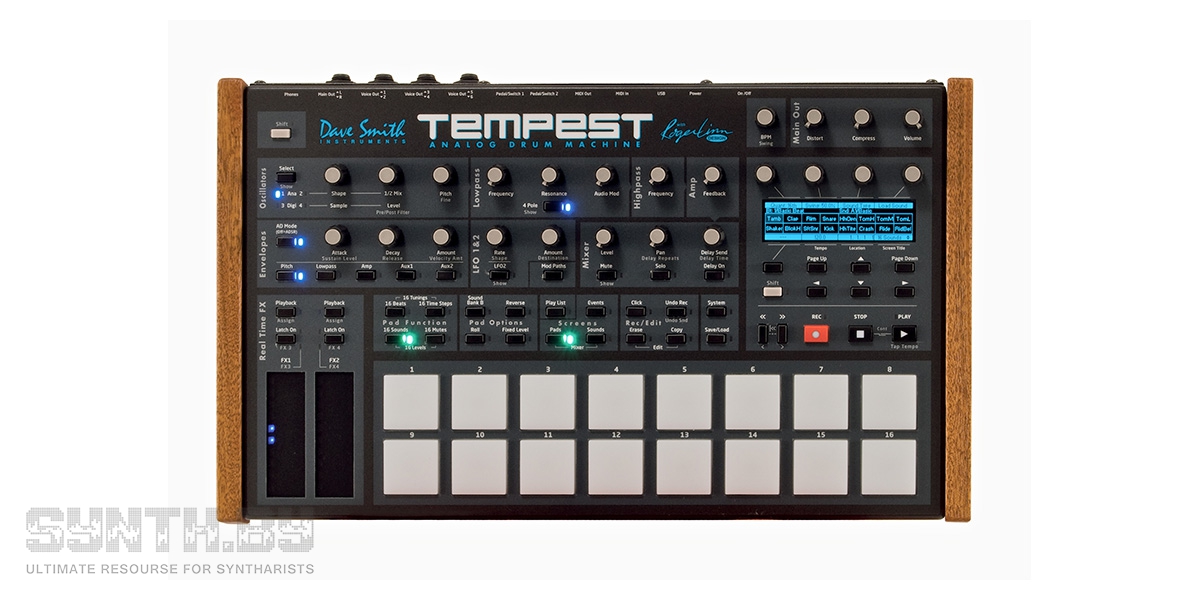 Drum machines of XX century are really amazing but we get even more impressed with modern hardware drummers. DSI Tempest is one of the brightest hybrid representatives. It was created by famed geniuses of electronic music world Dave Smith and Roger Linn. Both professionals did an excellent job together: Linn got himself busy with a digital part and sequencer design (AKAI MPC60 and 3000 style) and Smith got down to analog components of the structure. Linn and Smith didn’t actually try to surprise instrument fans with a fantastic sound architecture they made a step further – they crossed the line of long established norms and gave us a detonating cocktail of vintage chic and modern omnipotence. The core of it is enlivened with analog and digital drums, mono bass/leads/effects synthesis possibilities and many else.The waveforms are generated with two DCOs (saw, triangle, triangle/sawtooth). An additional sub (as you could see in Mopho and Tetra) produces a square wave one octave lower. Besides this there are 2 digital oscillators with one-shot samples (450 sounds). We can endlessly recount all the inner characteristics of that marvellous wonder but we should know our time and space also leaving it for looks and interface review. The rhythm machine is made of metal and wooden pieces and the interface was developed for easy live performance process. There are 16 blue lighted pads on its surface, 49 buttons, 24 knobs (among which – pitch and amp) and two ADSR envelopes assignable to any of 58 modulation sources. Under 2 ribbon controllers there are pitch/mod settings which interact with 2 LFOs. Mini mixer offers adjustable pan, volume, mute/solo. It’s worth noting that the instrument features lo-pass and hi-pass VCF as well as compression, distortion and delay effects. We expect to be shocked with happiness every time DSI or Roger Linn produces a new synth. But together they rendered us speechless in a quiet satisfaction. At least for a minute.
Drum machines of XX century are really amazing but we get even more impressed with modern hardware drummers. DSI Tempest is one of the brightest hybrid representatives. It was created by famed geniuses of electronic music world Dave Smith and Roger Linn. Both professionals did an excellent job together: Linn got himself busy with a digital part and sequencer design (AKAI MPC60 and 3000 style) and Smith got down to analog components of the structure. Linn and Smith didn’t actually try to surprise instrument fans with a fantastic sound architecture they made a step further – they crossed the line of long established norms and gave us a detonating cocktail of vintage chic and modern omnipotence. The core of it is enlivened with analog and digital drums, mono bass/leads/effects synthesis possibilities and many else.The waveforms are generated with two DCOs (saw, triangle, triangle/sawtooth). An additional sub (as you could see in Mopho and Tetra) produces a square wave one octave lower. Besides this there are 2 digital oscillators with one-shot samples (450 sounds). We can endlessly recount all the inner characteristics of that marvellous wonder but we should know our time and space also leaving it for looks and interface review. The rhythm machine is made of metal and wooden pieces and the interface was developed for easy live performance process. There are 16 blue lighted pads on its surface, 49 buttons, 24 knobs (among which – pitch and amp) and two ADSR envelopes assignable to any of 58 modulation sources. Under 2 ribbon controllers there are pitch/mod settings which interact with 2 LFOs. Mini mixer offers adjustable pan, volume, mute/solo. It’s worth noting that the instrument features lo-pass and hi-pass VCF as well as compression, distortion and delay effects. We expect to be shocked with happiness every time DSI or Roger Linn produces a new synth. But together they rendered us speechless in a quiet satisfaction. At least for a minute.
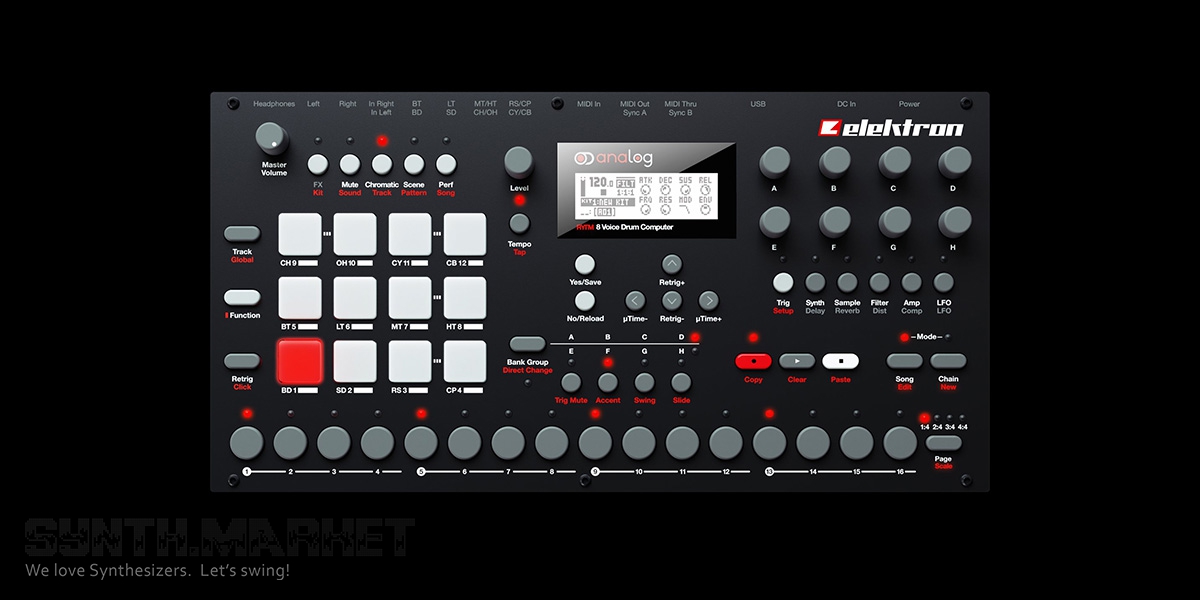 Elektron Analog RYTM came two years after DSI Tempest was released. And it slightly pressed its rival out (we’ll leave it here as an appropriate exaggeration). It sports an 8-voice analog core with digital envelopes, LFO and noise generator. RYTM has 12 pads with mildly attractive LEDs and each is responsible for a different number of oscillators. For example BD1 pad triggers a dual oscillator with Classic, Hard and FM modes. SNR, CP, RS pads also have 2 oscillators to control, and toms have only one. The biggest number of oscillators (6) was alloted to open/closed hi-hats, cymbals and cowbells. Interestingly RYTM can mutate from a drum machine into a synth which is intrinsic to a hybrid type. BD1 and 2 are versatile enough for simple bass and lead creation especially in combination with a powerful multimode filter. As for the sequencer, it numbers 64 patterns and 16 steps. All pads have an individual track so if you press kick, snare and hi-hats simultaneously in real time each element will be recorded onto its own separate track. Due to this feature all the recorded drum sounds are processed in a sequencer individually. This is exactly what Akai MPC lacks making us discern each sound in a loop in order to put them onto separate tracks. RYTM lets you to correct any failed record with the help of autoquantization functioning in a master mode or it can be set onto a certain track. The parameter change in a step sequence can be locked with the Parameter-Locking function. The effects section offers: distortion, reverb, delay and compression. DSI Tempest and RYTM will free you from any DAW which you always have to resort to because these hardware machines got what it takes to produce beat.
Elektron Analog RYTM came two years after DSI Tempest was released. And it slightly pressed its rival out (we’ll leave it here as an appropriate exaggeration). It sports an 8-voice analog core with digital envelopes, LFO and noise generator. RYTM has 12 pads with mildly attractive LEDs and each is responsible for a different number of oscillators. For example BD1 pad triggers a dual oscillator with Classic, Hard and FM modes. SNR, CP, RS pads also have 2 oscillators to control, and toms have only one. The biggest number of oscillators (6) was alloted to open/closed hi-hats, cymbals and cowbells. Interestingly RYTM can mutate from a drum machine into a synth which is intrinsic to a hybrid type. BD1 and 2 are versatile enough for simple bass and lead creation especially in combination with a powerful multimode filter. As for the sequencer, it numbers 64 patterns and 16 steps. All pads have an individual track so if you press kick, snare and hi-hats simultaneously in real time each element will be recorded onto its own separate track. Due to this feature all the recorded drum sounds are processed in a sequencer individually. This is exactly what Akai MPC lacks making us discern each sound in a loop in order to put them onto separate tracks. RYTM lets you to correct any failed record with the help of autoquantization functioning in a master mode or it can be set onto a certain track. The parameter change in a step sequence can be locked with the Parameter-Locking function. The effects section offers: distortion, reverb, delay and compression. DSI Tempest and RYTM will free you from any DAW which you always have to resort to because these hardware machines got what it takes to produce beat.
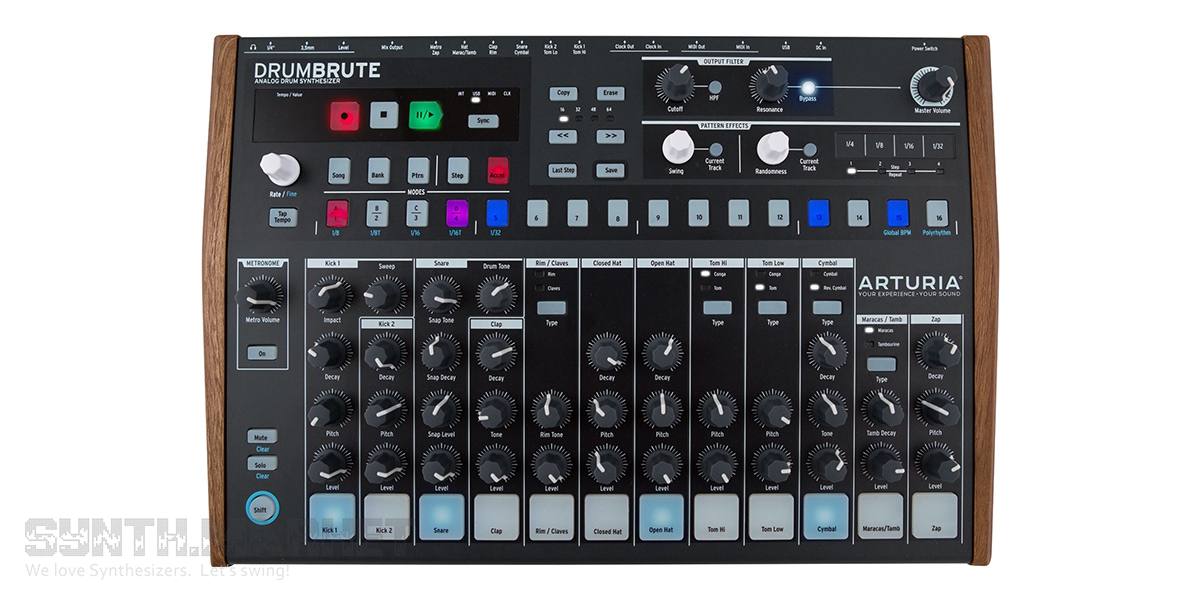 Up-and-coming Arturia DrumBrute keeps us in an agonizing anticipation and those who are really interested dream about this astonishing analog drum machine more and more every day. Why is it so alluring? It has a full analog path and a comparatively low price of $490. The library of the instrument includes 17 drum types: 2 kicks, snare, clap, clave/rimshot, open/closed hi-hats, toms, reversed cymbals, maracases, tambourines. Each sample features volume and solo/mute control as well as 12 individual outputs. Almost all drums have pitch and decay knobs. There is also a dual mode Steiner-Parker filter with adjustable resonance. Sequencer operates in real time and in a step mode. It comprises 4 banks with 64 patterns and the number may be multiplied in a press of a Song button. Loop examples sound quite convincingly and remind of classic TR-808 (deep kick and snappy snare). Analog synth DrumBrute (“drum beast”) can become popular and high in demand not only among musicians but also among live-performance devotees.
Up-and-coming Arturia DrumBrute keeps us in an agonizing anticipation and those who are really interested dream about this astonishing analog drum machine more and more every day. Why is it so alluring? It has a full analog path and a comparatively low price of $490. The library of the instrument includes 17 drum types: 2 kicks, snare, clap, clave/rimshot, open/closed hi-hats, toms, reversed cymbals, maracases, tambourines. Each sample features volume and solo/mute control as well as 12 individual outputs. Almost all drums have pitch and decay knobs. There is also a dual mode Steiner-Parker filter with adjustable resonance. Sequencer operates in real time and in a step mode. It comprises 4 banks with 64 patterns and the number may be multiplied in a press of a Song button. Loop examples sound quite convincingly and remind of classic TR-808 (deep kick and snappy snare). Analog synth DrumBrute (“drum beast”) can become popular and high in demand not only among musicians but also among live-performance devotees.
If we try to approach the skyline between us and hovering future we might presume (even if we fail) that digitally controlled analog path will prevail despite the fact that complete analog synths won’t lose their way to the shelves for sure as well. Analog is back in fashion although modern musicians still need to have their uniquely ordered parameters automatized, saved and stored and this is possible thanks to the digital processing of the signal which is entered with buttons, encoders and other control elements. We’ll end up having fully analog path with fully digital control. Hybrid synthesizers will win but this time they will conquer the world with a thrilling number of controllers onboard. Together with the killing interface here will come the riddance from the integration featuring wires – we’re waiting for Wi-Fi, Bluetooth and other wireless connectivity means.
Anyway drum machines, bass and percussive synthesizers will still deliver the same essence – the set of drum sounds for good fruitful work.

